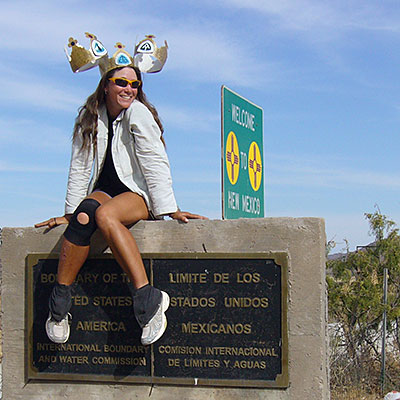
Kass at Antelope Wells border crossing station in New Mexico after finishing the Continental Divide Trail and the thru-hiker Triple Crown, November 2007. She thru-hiked the AT in 2004 and PCT in 2005.
"Outdoor enthusiasts are the current and future stewards of the trail," says Anitra Kass.
Kass speaks from experience. The thru-hiking Triple Crowner turned trail volunteer now helps protect, preserve, and promote the southern 700 miles of the Pacific Crest Trail.
In our Q&A with Kass, learn what it's like to be the Southern California Regional Representative for the Pacific Crest Trail Association.
What do you do at PCTA?
I am charged with having my hand in everything that happens on the southern 700 miles of the 2,600-mile PCT from a trail maintenance and operations standpoint.
Some examples are: submitting comments on proposed actions, supporting volunteer trail work crews, leading trail crews, providing volunteer training, meeting with agency partners, planning trail work for the coming year, conducting trail work assessments, routine office work like time sheets and expense reports, and many other things.
What's a typical workday? Is there such a thing?
There is no such thing as a typical day. A typical office day includes answering and reading 50 to 100 emails, working on upcoming project logistics, reading documents for proposed actions and/or commenting on them, setting up trail work schedules, usually a bunch of collaboration with one agency partner or another.
If I am in the field, the days are quite different. I could drive for three hours, get out, hike and scout for a few miles and then drive home, or camp out and do more scouting the next day.
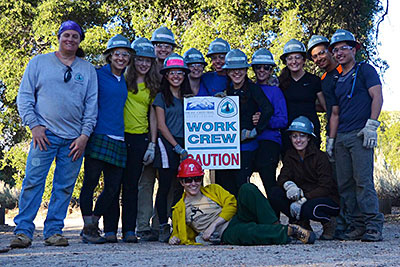 Kass, wearing her Phillies hard hat, with the University of Florida’s 2013 Alternative Spring Break crew, Cleveland National Forest, California.
Kass, wearing her Phillies hard hat, with the University of Florida’s 2013 Alternative Spring Break crew, Cleveland National Forest, California.If I am leading a weekend project, Friday I leave my house around 9 a.m., drive 1.5 hours to our tool cache, get the needed gear, drive to the project site, and set up base camp.
Volunteers arrive around dinnertime. I might do the cooking unless I have a volunteer. We usually wind down around 9 to 10 p.m. (depending on if it’s an adult trip or my high school students).
Saturday begins at 5:45 a.m. Safety gear and safety talk begin about 7:45 and around 8:30 a.m. the actual trail work begins. We arrive back at camp around 4 p.m. and have a little time to relax and clean up before the dinner crew arrives to help with dinner prep. Dinner is served between 5:30 and 6 p.m. Dessert follows quickly and then I am ready for bed.
If I have high school students, then I have to stay up and make sure they go to sleep (around 10 p.m.). Sunday has a similar start, but it typically is a half or three-quarter day of work.
These weekends are fun but exhausting.
How did you get involved?
I had always wanted to do a volunteer vacation on the Appalachian Trail, since I lived out east, but it was hard to take a full week of vacation to go do hard manual labor and not know if you even liked doing it. When you only have two weeks of vacation a year, that’s a hard sell.
After moving to California, hiking the AT (2004) and PCT (2005), and living pretty close to the PCT, when there was a one-day project at Silverwood Lake, I decided to sign up. One day I could handle. It was cool.
I still work with the leader, John Hachey, who set up that project. He reeled me into trail work. He was super nice and had a cool group of people on the project. The trail maintenance community has many similarities to the long-distance hiking community. I think that really appealed to me.
So I kept coming back and eventually got seasonal work in Colorado leading volunteer trail crews. In the summer of 2009 I lived in a tent on Mt. Massive in Colorado for 10 days out of every 14 and did trail work. I was in the best shape of my life at the end of that summer. After that, I started work at PCTA.
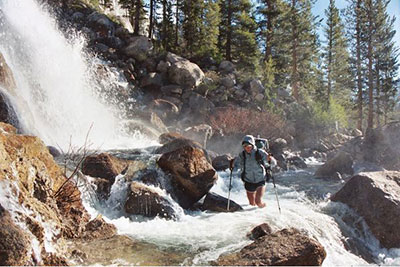
Kass crossing at a waterfall in the Sierra Nevadas, July 2005.
Why is your work relevant to trail enthusiasts?
If they like maintained trails, then my work is relevant. If they like trails protected from noise, light, and air pollution, then my work is relevant. If they like service work, then my work is relevant.
If they think green spaces are important for the environment, the ecosystem, or general well-being, then my work is relevant. If they’ve ever dreamed of a grand adventure, then my work is relevant.
What do you personally like to do outdoors?
Take a nap. Seriously, it’s my favorite thing to do, especially when I was a kid and we went camping and we had a hammock. I loved that thing. I enjoy camping a lot, especially sitting around a fire at night (assuming fires are allowed in the area I am camping). I could stare at the fire for hours. It just entrances me.
Obviously I love hiking and backpacking and trail work. There is something that I really love about getting to pristine locations that are stunningly gorgeous and knowing that few people have seen what my eyes behold.
How did you get started exploring outdoors and hiking?
My family went camping in Canada when I was young. I remember going every year until I was 18 (then I had a summer job). We’d hike and swim and play and that laid the foundation.
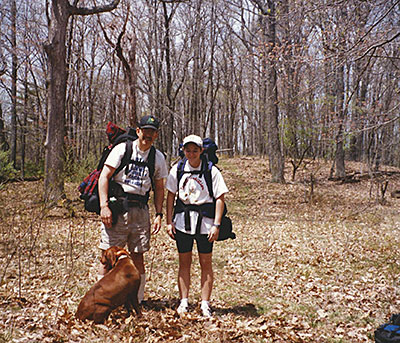
Kass with her dad and dog on their first backpacking trip, May 1998.
My first backpacking trip was in the spring of 1998. I went with my dad somewhere in either Virginia or West Virginia. It was seven miles to the campsite and three miles the next day to the car.
The seven miles almost killed us. We had our dog with us, we were all dehydrated, wearing cotton, with huge backpacks. We were passed by three guys who had done some backpacking and after hours we made it to camp and the guys were at the same spot.
We were exhausted and couldn’t figure out how to set up our tent (I had rented it from my college's recreation center) so the guys had to help us. I think my dad and I were pretty much done backpacking and we couldn’t wait to get to the car the next morning.
Then the guys said something that my dad and I remember to this day: ”We didn’t think you guys were going to make it.” Once they said that, Dad and I were hooked. We decided we would learn all we could about backpacking and gear and do it better next time. And after 7,500+ miles, we are doing pretty well.
My dad was a part of all of my thru-hikes. He has hiked from Springer Mountain, Georgia, to Damascus Virginia, on the AT. He has done a few hundred miles on the PCT in SoCal and the Sierra. He has done the CDT in Glacier National Park. We’ve done other trips over the years too, and thru-hiked the 50-mile Batona Trail in the New Jersey Pine Barrens.
Describe your ideal day outside.
I don’t have an ideal day. One day on the trail I decided I wanted to get up and hike 40 miles. Another day, I got up and decided I wanted to roll back over and go to sleep. So I woke up late, hiked for a while and then took a long nap at lunch…awesome. Another day, I woke up and did trail work and that was awesome. I do so many things outdoors that it’s hard to have an ideal day.
I think maybe the ideal day is just getting outside.
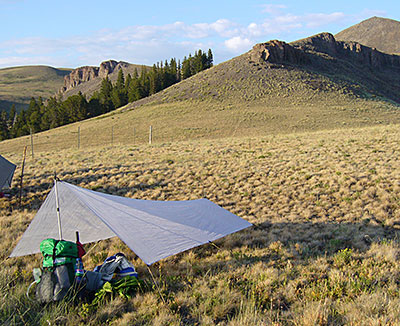
Kass's setup on the CDT, including one of her favorite gear pieces, her Mountain Laurel Designs tarp, on the Montana/Idaho border in 2007.
What are your favorite pieces of outdoor gear or apparel? Why?
For backpacking I have three favorites: my Marmot sleeping bag, my Mountain Laurel Designs tarp, and a small insulated mug my dad got for me from the hospital when his mom was there. All three made it the entire CDT (2007) and are continuing on strong. The mug actually has three long hikes on its resume.
For trail work I like my Phillies hard hat. It has a great suspension in it and I am a Phillies fan.
What’s in your backpack now?
First Aid kit, wag bag, spare eye protection, granola bar wrapper, pine needles and dirt from the last project, lots of pens, and a volunteer injury packet.
What's the best part of your job?
Paying it forward. Someone facilitated me having a great PCT experience in 2005, so I am glad to do the same thing for others. I can never pay back those who helped me; I can only pay it forward.
The worst?
Expense reports and time sheets are the worst. I am good at doing them—and I am very thorough—but I wish they would just do themselves.
Anything unusual your job involves?
Compared to most “regular jobs” my whole job is pretty unusual. I think I talk about poop a lot. When your job concerns dealing with human waste in the backcountry, and sometimes front country, the topic comes up a lot, so that’s probably unusual for a work environment, probably not so much for a group of hikers and outdoors enthusiasts.
What's your favorite outdoor book?
I enjoy memoirs of hikers hiking in a location where I’ve been or where I am prepping to go. I like to have that connection. I enjoyed A Walk in the Woodsby Bill Bryson, because I enjoy good writing and humor. I also enjoyed Colin Fletcher’s The Thousand-Mile Summer. The book Alive about the plane crash in the Andes was pretty remarkable.
What's your favorite quote?
It’s certainly the most factual: ”If it wasn’t for the last minute, I’d never get anything done.”
This one is pretty good also: “The act of driving your body, very occasionally, close to its limit of endurance is for some reason one of life’s major satisfactions. And relaxing afterwards is one of life’s most luxurious rewards.” Colin Fletcher in The Thousand-Mile Summer.
What are your favorite spots?
On my “must see” list for people are the following locations:
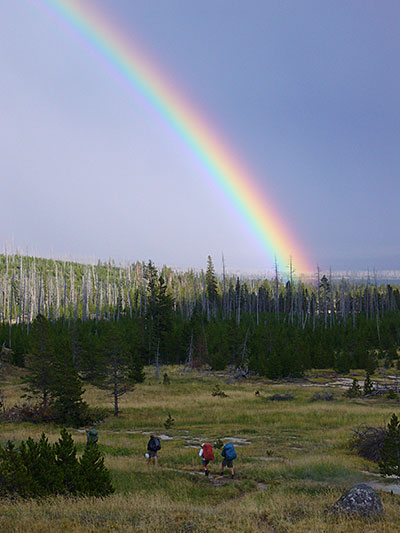
Yellowstone National Park thru-hikers near Heart Lake on the CDT.
the Wind River Range and Teton Wilderness in Wyoming; Mt. Massive in Colorado, especially when the wildflowers are blooming; the Galapagos Islands, where you can snorkel with gigantic sea turtles and hike on volcanoes and lay in a hammock on the beach; the PCT from Chicken Spring Lake to Hwy 80 in the Sierra Nevada Mountains of California; the Grand Canyon; Whitewater Preserve in Southern California; Ghost Ranch and the Rio Chama River in New Mexico; the Gila River and Cliff Dwellings in New Mexico; anywhere in the desert in the spring time;
the White Mountains of New Hampshire, especially if you can find a little space without a ton of people (it’s pretty popular and busy); Mt. Katahdin in Maine; the Rideau Canal system in Canada (where my family went camping and sailing as a child), they have an awesome system of functional locks; the Bob Marshall Wilderness in Montana; the Anaconda-Pintler Wilderness of Montana; anywhere you can see Mount Rainer; every National Park in Utah; and Crater Lake National Park in Oregon.
There are so many great places you can go.
What role do outdoor recreation enthusiasts play in PCTA's mission?
They play a major role. They are the users of the PCT and they become intimately involved in protecting, preserving, and promoting the trail. Some become volunteers (that’s how I got my start) to help maintain the trail and others become members of the PCTA and help fund the programs and services we provide.
Outdoor recreation folks share their experiences and stories with people, who promote the trail to others. You can Google “PCT” and find tons of blogs and journals about hiking or horseback riding on the trail. You can join any number of Facebook groups about the trail and I am sure there are Twitter feeds and Instagram photos of folks hiking.
Enthusiasts also communicate with their representatives when issues affect the trail and the surrounding environment and they make comments to their local BLM and USFS offices on proposed actions impacting the trail. Outdoor enthusiasts are the current and future stewards of the trail and PCTA.
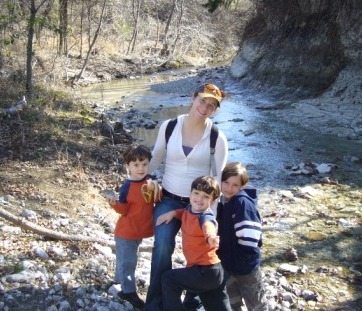
Kass on a nature walk in Texas with her cousins.
What do you think is the biggest threat to the outdoors now?
Lack of exposure to all the outdoors has to offer us as individuals, communities, and ecosystems. Once a person is involved, a love and appreciation for the outdoors grows, and then they expose other people to it and they take care of the outdoors.
I’ve experienced this a lot with my high school and middle school programs.
Why should Trailspace members join PCTA? How can they get engaged?
I became a member of the PCTA when I did my 2005 thru-hike. I felt that I should support the organization that was helping to facilitate my thru-hike and I encourage all thru-hikers, alumni or future, to join the organization of the trail you hiked or will hike.
To help the PCTA protect, preserve, and promote the PCT, the best way is to become a member. Membership helps fund important trail maintenance and protection programs and it helps us promote the trail through publications like the PCT Communicator and PCTA website.
And if you want to stay informed regarding issues affecting the trail, PCTA membership is a surefire way to stay informed. Visit www.pcta.org to find more information regarding PCTA programs, trail use, volunteer opportunities, and membership.
Trailspace annually supports environmental nonprofits important to backcountry recreation, like the Pacific Crest Trail Association.
But, do you know the people behind these outdoor organizations, the individuals that professionally steward, support, and advocate for the mountains, crags, forests, rivers, and lakes we enjoy exploring? Read about other environmental nonprofits.

 by Alicia MacLeay
by Alicia MacLeay









